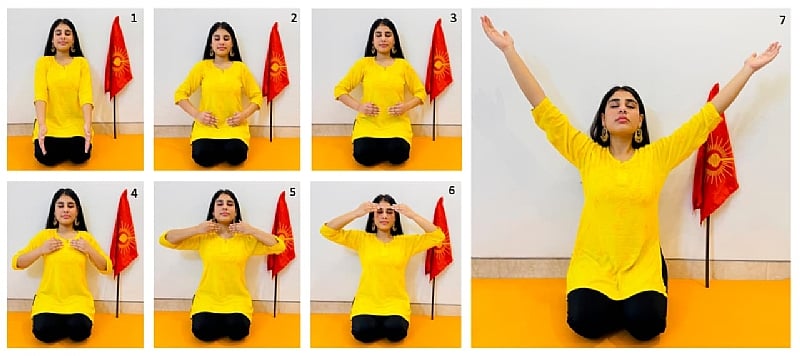The human experience extends beyond the tangible physical body into a realm of subtle energies. Recent experimentation with palm chakra scanning elicited a range of sensations in participants, highlighting the existence of this energetic layer often referred to as the aura or pranamaya kosha. This energetic field acts as a control center for the physical body, influencing its health and well-being. While the physical body is a temporary vessel for the soul, subject to eventual decay, the rate of this deterioration, or aging, is within our control. Ancient Vedic sages, deeply versed in the science of yoga, understood and mastered these subtle energetic layers, maintaining vibrant, youthful bodies throughout their lives. Modern practitioners of the Sanatan Kriya tradition stand as testaments to the efficacy of this ancient science, demonstrating remarkable vitality and radiance.
The foundation of yogic practice lies in the efficient utilization of the body’s resources, specifically the prana, or life force energy. Seven major chakras, acting as energetic hubs within the body, facilitate the flow of prana, expelling stagnant energy and drawing in fresh vitality. These chakras govern the function of specific organs and body parts, and imbalances in their pranic flow manifest as illness or disease. Therefore, purifying and strengthening both the physical and etheric layers is crucial for maintaining health. The Sanatan Kriya tradition offers powerful practices to achieve this energetic balance, including the Chakra Santulan Pranayam.
Chakra Santulan Pranayam is a specialized breathing technique designed to redistribute prana throughout the chakra system, addressing deficiencies and surpluses to prevent and alleviate disease. The practice begins in Vajrasana, a kneeling posture, with a full yogic breath, engaging both abdominal and thoracic regions. As the breath is exhaled, palms face downward towards the Mooladhar chakra, located at the base of the spine. With the subsequent inhalation, performed using the Ujjayi breath (a constricted throat breath), the palms are raised sequentially through each chakra: Swadhishthan (just above the pubic bone), Manipura (navel), Anahata (heart center), Vishuddhi (throat), and Ajna (between the eyebrows). Finally, the palms extend upwards towards the Sahasrara chakra, visualized as a golden globe above the head. The breath is held briefly in this posture.
The exhalation reverses this process, slowly lowering the palms with a pause at each chakra, returning to the Mooladhar. This constitutes one cycle of the pranayama. A complete set of Chakra Santulan comprises seven such cycles, synchronizing hand movements with the breath. It’s important to avoid strain and to gradually build up the practice. Initially, the hand movements may feel rushed, but with consistent practice, coordination and control will improve. Each chakra governs specific bodily functions and possesses unique properties, detailed in the text “Sanatan Kriya, Essence of Yoga.” Advanced practitioners can utilize these chakra forces for specific outcomes.
The seven chakras, each associated with specific physiological and psychological functions, play a vital role in maintaining overall well-being. The Mooladhar chakra, situated at the base of the spine, represents the foundation of our physical existence and governs survival instincts, grounding, and stability. The Swadhishthan chakra, located above the pubic bone, is associated with creativity, pleasure, and emotional well-being. The Manipura chakra, residing at the navel, is the center of personal power, will, and self-esteem. The Anahata chakra, situated at the heart center, is associated with love, compassion, and emotional balance. The Vishuddhi chakra, located in the throat region, governs communication, self-expression, and creativity. The Ajna chakra, residing between the eyebrows, is the center of intuition, wisdom, and inner vision. The Sahasrara chakra, located at the crown of the head, represents spiritual connection, enlightenment, and unity consciousness.
Balancing these chakras through practices like Chakra Santulan Pranayam can positively influence physical, emotional, and mental well-being. By optimizing pranic flow, this practice can enhance vitality, strengthen the immune system, improve emotional regulation, and promote mental clarity. The synchronization of breath and movement in Chakra Santulan Pranayam further cultivates a deeper connection between the physical and energetic bodies, fostering a sense of wholeness and harmony. Regular practice of this powerful pranayama can lead to a healthier, more balanced state, reducing susceptibility to disease and promoting overall well-being.
Ashwini Guruji, the guiding light of Dhyan Foundation and a recognized authority on Vedic sciences, has further elucidated the principles of Sanatan Kriya and its anti-aging benefits in his acclaimed book, “Sanatan Kriya, The Ageless Dimension.” This text provides a deeper exploration of the subtle energies within the body and the practices that harness their potential for optimal health and longevity. The teachings emphasize the interconnectedness of the physical, energetic, and spiritual dimensions of human existence, offering a holistic approach to well-being.
For those seeking to explore the profound wisdom of Sanatan Kriya and experience its transformative effects, further information and guidance can be found on the Dhyan Foundation website or by contacting them directly. The foundation offers resources and support for individuals interested in learning and practicing these ancient techniques, empowering them to unlock their full potential for health, vitality, and spiritual growth. The practice of Chakra Santulan Pranayama, along with other Sanatan Kriya techniques, offers a path towards a healthier, more balanced, and fulfilling life, echoing the wisdom of the ancient Vedic sages.


